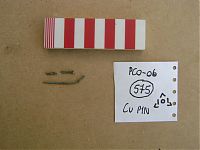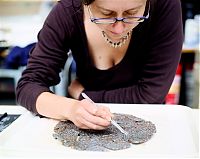Registered, Special, Small, or Accessioned?
- By: Guy Hunt |
- Oct 25, 2010
- Share
- del.icio.us

One annoying bit of terminology that we often get confused about concerns the name we give to finds that stick out from the rest of the assemblage. These are often called small finds, special finds, objects, registered or reg finds or accessioned finds. I will do my best to explain what we mean by these terms and hopefully that will help people use the data on this site.
The good news is that we have just published our entire registered finds catalogue on ARK. This compliments the Objects data that we already published during our dig.
So first up, terminology: Small and Special are both terms used more or less interchangeably in the field to mean any object that stands out from the norm on site. As you can see, this is a pretty woolly definition, and the use of both terms originated in the early days of archaeology. Classifying some finds as ‘small’ seems odd really, especially bearing in mind that size is definitely not in the criteria by which we classify ‘small’ finds. The other common term ‘special finds’ is perhaps nearer the mark in that it is vaguely defining something out of the norm, in other words, here is a find that isn’t going to get bagged up with all the other finds in bulk.

This copper pin is the sort of find that is liable to get lost or damaged if it isn’t packaged and recorded on site.
So what do we mean my special finds and is this a useful thing to be doing on site? Well, in my opinion it is worthwhile for a couple of reasons.
Firstly, certain objects need to be treated more carefully and may require conservation. In this case, these objects can’t be bagged up with all the bulk finds (big bags of pot sherds or bricks) because they would get destroyed in no time. The tiny copper pin <101> in the picture for instance is the type of fragile object that needs to be packaged individually. We might also want to send these objects off quickly to conservation. These finds might also need to be stored in special packaging or kept wet like these shale objects .
Secondly, by identifying certain finds as ‘special’, we are then able to record specific information about that find on site. This might include specific location information like an accurate XYZ location. Don’t forget that all finds have their context information recorded, but special finds get their own coordinates. The special find numbers can also be annotated on plans and so on.
Thirdly, in a big site like Prescot Street, finds are liable to get mixed up and lost if they aren’t properly catalogued and listed. By making a list of ‘special’ finds, we are able to keep tabs on what we’ve found and where it is. Often these finds are indeed small, and so they are particularly prone to getting lost.

A special find from site being conserved in the lab at the Museum of London. This is the sort of find that will become an ‘accessioned find’.
So, what about Registered or Accessioned finds? Well, once certain types of objects go to the museum, these items will be individually catalogued into the museum’s archive. In the most part, this includes all of our on site ‘special’ finds, but it also includes a lot of additional material that has been identified during the conservation and finds processing work. These finds have all been conserved and properly examined by specialists and so our rough and ready site identifications have in many cases been updated and corrected. Where possible, the date of the object has been given.
I hope that this explanation is helpful and please get in touch if you have any queries about the data. I will be publishing the assessment report on these finds very soon too!
- (0)